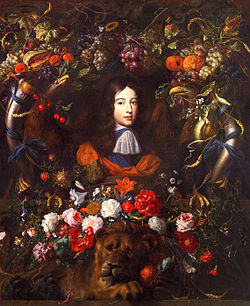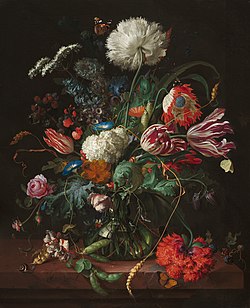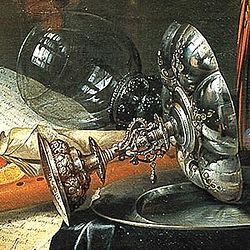Jan Davidsz. de Heem

Jan Davidszoon de Heem , or Jan Davidsz for short . de Heem (April 1606 in Utrecht ; † 1683 or 1684 in Antwerp ), was a Dutch painter, contemporary of Rembrandt, one of the most important representatives of Dutch still life painting of the 17th century and son of the still life painter David de Heem.
Life
Jan Davidsz. de Heem was a student of the still life painter Balthasar van der Ast (1593–1656) and Daniel Seghers (1590–1661).
From 1625 to 1629 he worked in Leiden , was enrolled in the Antwerp painters' guild in 1635 and became a citizen of the city the following year. Around 1667 he went back to Utrecht, from where he fled to Antwerp in 1672 when the French invaded. De Heem was the greatest flower and fruit painter in the Dutch school. He combined microscopic delicacy of execution with the greatest brilliance of the coloristic representation and the finest taste in the arrangement. He painted vases with bouquets of flowers, often populated with insects and butterflies, wreaths of flowers around niches, windows and images of the Madonna imitated in stone colors, fruit hangings, still lifes with filled wine glasses, grapes and other fruits, food, etc.
He knew how to increase the fineness of the coloring to the point of transparency, so that his reproductions of dead nature achieve the appearance of perfect natural truth. Pictures of his hand can be found in almost all larger picture galleries (still life with chalice and host surrounded by garlands, Kunsthistorisches Museum Wien ; still life with the Eye of Providence in a niche surrounded by fruit and flower pendants and another with niche and fruit and flower pendants in Berlin Museum).
His sons Cornelis de Heem (1631–1695) and Jan Jansz de Heem (1650 – after 1695) were pupils of their father and worked partly in The Hague and partly in Antwerp. They created flowers and pieces of fruit as well as still lifes in the style of their father's painting.
To Jan Davidsz. de Heem's students also included Jacob Marrel , who had previously studied with Georg Flegel , Abraham Mignon and Maria van Oosterwijk .
Catalog raisonné
- Bouquet of flowers in a glass vase, Gemäldegalerie Berlin .
- Fruit and flower hangings, oak, 37 × 68 cm, Gemäldegalerie Berlin (Friedrichshain lost in the war).
- Fruit and flower cartouche with wine glass, 1651, Gemäldegalerie Berlin.
- Painted frame with fruits and flowers, 1650, Gemäldegalerie Berlin.
- Magnificent still life with a glass goblet, butterfly and lemon, oil on oak, 33.3 × 48.6 cm, Hampel, Munich, December 2015.
- Still life with fruits and lobsters, Gemäldegalerie Berlin.
- Still life with fruit with oysters and wine glass, oil / wood, 47.4 × 63.4 cm, Herzog Anton Ulrich-Museum , Braunschweig .
- Splendid still life with ham, oysters, fruit and a parrot, oil / canvas, 115.5 × 169.5 cm, picture gallery of the Academy of Fine Arts Vienna .
- Still life, oil on wood, 54.8 × 79.5 cm, September 20, 2013, Koller auction house, Zurich.
literature
- Wilhelm Adolf Schmidt: Heem, de . In: Allgemeine Deutsche Biographie (ADB). Volume 11, Duncker & Humblot, Leipzig 1880, pp. 232-234.
- Sam Segal: Still Life in the Golden Century - Jan Davidsz. de Heem and his circle. Exhibition in the Centraal Museum in Utrecht, February 16 - April 14, 1991, and in the Herzog Anton Ulrich Museum in Braunschweig, May 9 - July 7, 1991. Herzog-Anton-Ulrich-Museum, Braunschweig 1991. ISBN 3-922279 -19-8 .
Web links
Individual evidence
- ↑ Christina Becela-Deller: Ruta graveolens L. A medicinal plant in terms of art and cultural history. (Mathematical and natural scientific dissertation Würzburg 1994) Königshausen & Neumann, Würzburg 1998 (= Würzburg medical-historical research. Volume 65). ISBN 3-8260-1667-X , pp. 201–203 and 211.
| personal data | |
|---|---|
| SURNAME | Heem, Jan Davidsz. de |
| ALTERNATIVE NAMES | De Heem, Jan Davidsz .; Heem, Jan Davidsz de; Heem, Jan Davidsz. de |
| BRIEF DESCRIPTION | Dutch painter |
| DATE OF BIRTH | April 1606 |
| PLACE OF BIRTH | Utrecht |
| DATE OF DEATH | 1683 or 1684 |
| Place of death | Antwerp |






